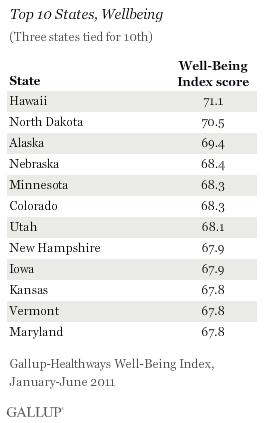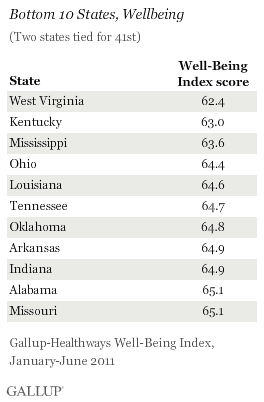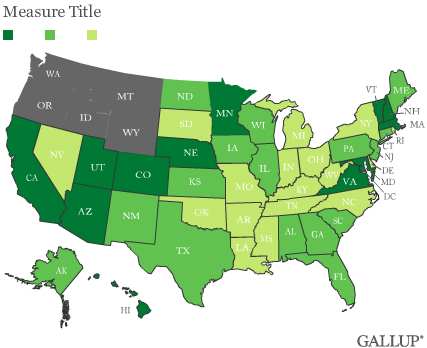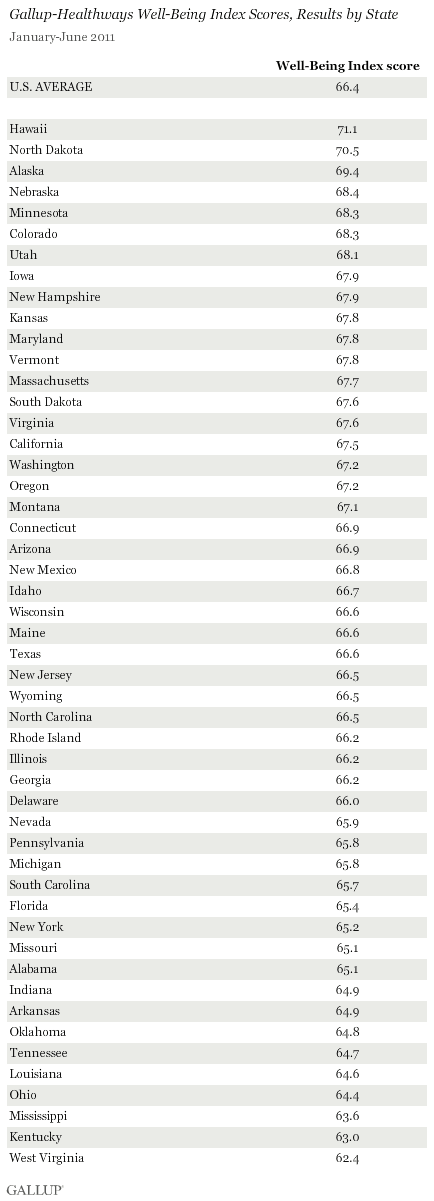WASHINGTON, D.C. -- Americans in Hawaii continued to set the national standard in well-being in the first half of 2011, followed closely by North Dakota. West Virginia and Kentucky maintained their status as the states with the lowest well-being. Nebraska, which showed the biggest gains in well-being rank from 2009 (25th) to 2010 (10th), continued to move up, landing in the top five.


These state-level data, from the Gallup-Healthways Well-Being Index, are meant to provide a preliminary reading on the well-being of U.S. states in anticipation of the complete 2011 rankings, to be released early next year.
The Well-Being Index score for the nation and for each state is an average of six sub-indexes, which individually examine life evaluation, emotional health, work environment, physical health, healthy behaviors, and access to basic necessities. The January through June 2011 aggregate includes more than 177,000 interviews conducted among national adults, aged 18 and older.
The midyear Well-Being Index score for the country so far in 2011 is 66.4, a slight decline from . The Well-Being Index is calculated on a scale of 0 to 100, where a score of 100 would represent ideal well-being. Well-Being Index scores among states vary by a range of 8.7 points.
Southern States Continue to Struggle With Low Well-Being
More states in the South than anywhere else in the country have well-being scores in the lower range, as has been true in the past. Eight of the bottom 11 states in well-being (Missouri is classified as a Midwestern state) are Southern states.
Many Western states, in contrast, thrive in well-being, with four out of the top seven -- Hawaii, Alaska, Colorado, and Utah -- located in that region of the country. Five Midwestern states -- North Dakota, Nebraska, Minnesota, Kansas, and Iowa -- are also in the top 12, as are three Eastern states: New Hampshire, Vermont, and Maryland.

North Dakota's Well-Being Index composite score has moved up proportionally more than any other state since last year, to 70.5 from 68.4. Well-being in Wyoming has declined the most, dropping to 66.5 thus far in 2011 from 69.2 last year, though Wyoming has a relatively small sample size at the halfway point of the year, and thus, a larger margin of error. (See page 2 for a complete list of state Well-Being Index scores.)
Hawaii Again Tops List in Emotional and Physical Health
On the sub-indexes that make up the broader Well-Being Index, Hawaii is tops in Emotional Health and Physical Health, two domains in which it perennially leads the nation. Alaska does the best on Life Evaluation, North Dakota on Work Environment, and Vermont on Healthy Behavior, typically its strongest area. Massachusetts, which is always at or near the top in Basic Access, is once again leading on that dimension thus far in 2011.
At the bottom, West Virginia fares worst on Life Evaluation and Physical Health -- two areas in which residents of this state have seriously struggled since the launch of the Well-Being Index in 2008. Kentucky performs worst on Emotional Health, and Mississippi is again at the bottom on Basic Access, consistent with three previous years of tracking. Louisiana has the lowest Work Environment score so far in 2011, replacing Delaware for the first time since 2009 in that bottom spot. Oklahomans exhibit the unhealthiest behaviors.

Implications
The overall well-being of the nation has thus far trended down 0.4 points in 2011, representing a modest decline from 2010 in Americans' collective well-being. At midyear, many of the usual Western, Midwestern, and Eastern states top the country in well-being, while Southern states are again more prevalent toward the bottom of the list. The states at the very top and very bottom have remained largely unchanged since 2008, demonstrating highly consistent patterns over time.
About the Gallup-Healthways Well-Being Index
The Gallup-Healthways Well-Being Index tracks U.S. well-being and provides best-in-class solutions for a healthier world. To learn more, please visit .
Survey Methods
Results are based on telephone interviews conducted as part of the Gallup-Healthways Well-Being Index survey Jan. 2-June 30, 2011, with a random sample of 177,600 adults, aged 18 and older, living in all 50 U.S. states and the District of Columbia, selected using random-digit-dial sampling.
For results based on the total sample of national adults, one can say with 95% confidence that the maximum margin of sampling error is 卤0.2 percentage points. The margin of sampling error for most states is 卤1-2 percentage points, but is as high as 卤4 points for smaller states such as Wyoming, North Dakota, South Dakota, Nebraska, and Hawaii.
Interviews are conducted with respondents on landline telephones and cellular phones, with interviews conducted in Spanish for respondents who are primarily Spanish-speaking. Each daily sample includes a minimum quota of 400 cell phone respondents and 600 landline respondents, with additional minimum quotas among landline respondents for gender within region. Landline respondents are chosen at random within each household on the basis of which member had the most recent birthday.
Samples are weighted by gender, age, race, Hispanic ethnicity, education, region, adults in the household, and phone status (cell phone only/landline only/both, cell phone mostly, and having an unlisted landline number). Demographic weighting targets are based on the March 2010 Current Population Survey figures for the aged 18 and older non-institutionalized population living in U.S. telephone households. All reported margins of sampling error include the computed design effects for weighting and sample design.
In addition to sampling error, question wording and practical difficulties in conducting surveys can introduce error or bias into the findings of public opinion polls.
For more details on Gallup's polling methodology, visit .

